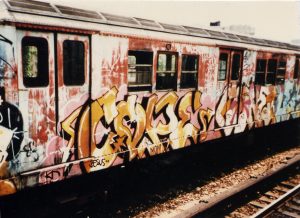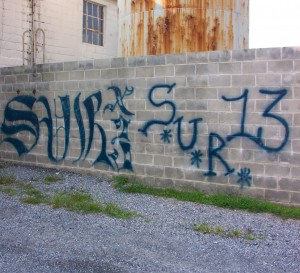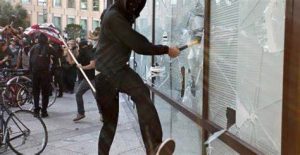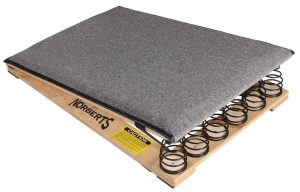4 Reading
A) Pre-reading Discussion Questions
You have listened to a talk about using public spaces to communicate with the broader community and developed your listening skills. Now you will read a magazine article about the history of graffiti. Discuss the questions below with a partner.
- Is graffiti a popular form of expression in your country? Or do the authorities prohibit it?
- Do you think graffiti is an artform? If not, why not?
- Have you ever seen any street art? What type?
B) Vocabulary Preview
| Word | Meaning | Your own sentence |
| graffiti (N)
|
|
|
| masterpiece (N)
|
|
|
| gang (N)
|
|
|
| territory (N)
|
|
|
| regard (V)
|
|
|
| canvas (N)
|
|
|
| vandalism (N)
|
|
|
| vibrant (adj)
|
|
|
| springboard (N)
|
|
|
| political (adj)
|
|
|
| reclaim (V)
|
|
|
| crew (N)
|
|
|
C) Survey the text
1. A. Skim through the text that follows and match the headings below with appropriate places for them in the text. Drag each heading to the appropriate heading letter. Then type each heading into the space provided in the text (under Heading A, B, C, D).
The History of Graffiti
The first drawings on walls appeared in caves thousands of years ago. Later the Ancient Romans and Greeks wrote their names and protest poems on buildings. Modern graffiti seems to have appeared in Philadelphia in the early 1960s, and by the late sixties it had reached New York.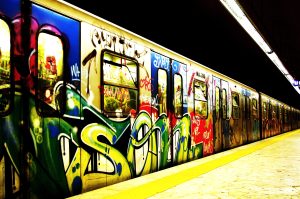 The new art form really took off in the 1970s, when people began writing their names, or ‘tags’, on buildings all over the city. In the mid seventies it was sometimes hard to see out of a subway car window, because the trains were completely covered in spray paintings known as ‘masterpieces’.
The new art form really took off in the 1970s, when people began writing their names, or ‘tags’, on buildings all over the city. In the mid seventies it was sometimes hard to see out of a subway car window, because the trains were completely covered in spray paintings known as ‘masterpieces’.
In the early days, the ‘taggers’ were part of street gangs who were concerned with marking their territory. They worked in groups called ‘crews’ and called what they did ‘writing’ – the term ‘graffiti’ was first used by The New York Times and the novelist Norman Mailer. Art galleries in New York began buying graffiti in the early seventies. But at the same time that it began to be regarded as an art form, John Lindsay, the then mayor of New York, declared the first war on graffiti. By the 1980s it became much harder to write on subway trains without being caught, and instead many of the more established graffiti artists began using roofs of buildings or canvases.
The debate over whether graffiti is art or vandalism is still going on. Peter Vallone, a New York city councillor, thinks that graffiti done with permission can be art, but if it is on someone else’s property it becomes a crime. ‘I have a message for the graffiti vandals out there,’ he said re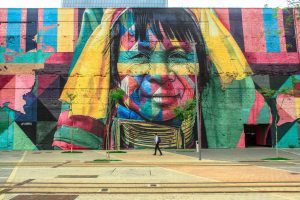 cently. ‘Your freedom of expression ends where my property begins.’ On the other hand, Felix, a member of the Berlin-based group Reclaim Your City, says that artists are reclaiming cities for the public from advertisers, and that graffiti represents freedom and makes cities more vibrant.
cently. ‘Your freedom of expression ends where my property begins.’ On the other hand, Felix, a member of the Berlin-based group Reclaim Your City, says that artists are reclaiming cities for the public from advertisers, and that graffiti represents freedom and makes cities more vibrant.
For decades graffiti has been a springboard to international fame for a few. Jean-Michel Basquiat began spraying on the street in the 1970s before becoming a respected artist in the ’80s. The Frenchman Blek le Rat and the British artist Banksy have achieved international fame by producing complex works with stencils, often making political or humorous points. Works by Banksy have been sold for over £100,000. Graffiti is now sometimes big business.
D) Comprehension Questions
Look back at the text to answer the following questions.
E) Paraphrasing
Paraphrase each of the following excerpts from the reading as you would if you wanted to include the information in a summary.
F) Follow-up Writing
In what ways are Candy Chang’s Before I die, I want to…wall similar to graffiti and different at the same time? Write one paragraph below approximately 200 words. Use at least 5 infinitives and 5 gerunds.
H) Follow-up Discussion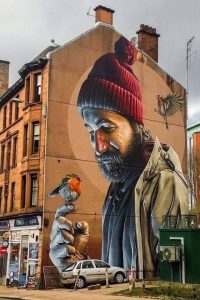
- Have you seen any of the works created by any of the artists mentioned in the reading? Look at some of the examples shown by your instructor. Would you pay the large sums of money that buyers have paid for them?
- Would you be happy or angry if there was a large amount of graffiti in your neighbourhood? Would it make a difference to your feelings if the property owner had given their permission to the graffiti artist?
- Would you ever give permission for such art on your property? If so, what type of images would you want?
- What do you think the penalty should be for people who graffiti buildings without the owners’ permission?
